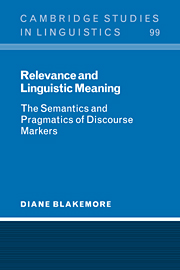Conclusion
Published online by Cambridge University Press: 18 December 2009
Summary
Research on discourse markers has been dominated by taxonomy and classification. As I have shown in the final chapter of this book, this is matched by a corresponding focus on the classification of coherence or discourse relations. In neither case has this concern with classification yielded an account of discourse markers that is universally accepted by those who are working with them. Indeed, as I remarked in the introduction to this book, it is not even agreed what the set of discourse markers for any given language is. It seems that in general, classifications are made at a descriptive level: the aim is to describe the role that these expressions play either in constructed examples of acceptable uses (see Halliday and Hasan 1976) or in naturally occurring discourse (see Schiffrin 1987, 1994). In these approaches, the evidence for any generalization made is always positive. Thus there is not a single example of an unacceptable use of a conjunctive cohesive device in Halliday and Hasan's book, and, since Schiffrin's examples are all examples of actual uses, there are no unacceptable uses of the expressions she classifies as discourse markers either. However, as is so often the case in linguistics, we often learn more about the meanings of these expressions from the fact that they cannot occur in a particular context than the fact that they can occur in another.
- Type
- Chapter
- Information
- Relevance and Linguistic MeaningThe Semantics and Pragmatics of Discourse Markers, pp. 184 - 185Publisher: Cambridge University PressPrint publication year: 2002

